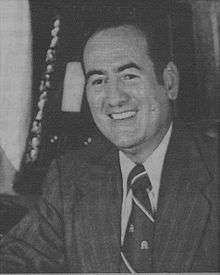Carlos Humberto Romero
General Carlos Humberto Romero Mena (February 29, 1924[1] – February 27, 2017) was a Salvadoran politician who served as President of El Salvador[2] between July 1, 1977, and his overthrow on October 15, 1979.
Carlos Humberto Romero | |
|---|---|
 | |
| 37th President of El Salvador | |
| In office July 1, 1977 – October 15, 1979 | |
| Vice President | Julio Ernesto Astacio |
| Preceded by | Arturo Armando Molina |
| Succeeded by | Revolutionary Government Junta Álvaro Magaña as President |
| Personal details | |
| Born | Carlos Humberto Romero Mena February 29, 1924 Chalatenango, El Salvador |
| Died | February 27, 2017 (aged 92) San Salvador, El Salvador |
| Nationality | Salvadoran |
| Political party | National Conciliation Party |
| Military service | |
| Allegiance | |
| Branch/service | Salvadoran Army |
| Rank | General |
Early life
Romero was born in Chalatenango, El Salvador, on February 29, 1924.
Military Career
Romero studied at the Captain General Gerardo Barrios Military School and the Command and General Staff School. He did specialized horse riding studies in Mexico.
Romero was a member of the National Conciliation Party,[3] and also served as Defense Minister from 1972 to 1973.
He launched his candidacy for the National Conciliation Party (PCN) in the February 1977 presidential elections. On February 24, the Central Elections Council declared that he had won the election and was to be sworn in as President while Julio Ernesto Astacio was declared Vice President.[4] The opposition forces grouped in the National Opposition Union (UNO) filed complaints about numerous acts of fraud[5] and electoral coercion[6] committed in the vote. The period between his election and the inauguration proved to be extremely dangerous for his opponents. On February 28, 1977, the military forces dissolved a UNO protest rally in the Plaza Libertad in San Salvador.
Presidency

General Romero was sworn in on July 1, 1977. He responded to accusations of "electoral fraud" by declaring a state of emergency for thirty days and established a rigidly conservative government.
Romero's time in office was largely characterized by escalating violence and instability. In the late 1970s, political unrest increased, because of El Salvador's severe socio-economic inequalities unaddressed by his government and widespread discontent with government policy culminated in widespread protest and rebellion, which was met with reprisal by government forces. President Romero increased government education spending, but this won him no popularity with the left. The different police, military and government paramilitary forces launched a bloody repression campaign against leftist groups that ended the lives of 4 Catholic priests and numerous leaders and militants of workers and peasant organizations. He is accused of having ordered the student massacre of July 30, 1975. Left-wing armed groups responded to the violence exerted by the State with attacks on the security forces and government officials. The repression plunged the country into a serious social crisis.
Romero held power until October 1979, when he was deposed with a reformist coup d'état by dissident, politically leftist and moderate military officers and civilians.[7] The coup d'état that deposed Romero was preamble to El Salvador's twelve-year civil war.
Later Life and Death
After being deposed, Romero lived in exile in Guatemala before returning to El Salvador. He died on 27 February 2017 at the age of 92 of natural causes. [8][9]
Orders and Decorations
![]()
References
- Copley, Gregory R. (October 11, 1980). "Defense & Foreign Affairs Handbook". G. R. Copley. Retrieved October 11, 2019 – via Google Books.
- "Gral. Carlos Humberto Romero Mena" (in Spanish). Asamblea Legislativa de El Salvador. Archived from the original on March 4, 2016. Retrieved January 13, 2017.
- "Google News Archive Search". news.google.com.au. Archived from the original on December 30, 2012. Retrieved October 11, 2019.
- "«Consejo Central de Elecciones»" (PDF). Diario Oficial. March 2, 1977.
- Nohlen, D (2005) Elections in the Americas: A data handbook, Volume I, p276 ISBN 978-0-19-928357-6
- Herman, Edward S. and Frank Brodhead (1984) Demonstration elections: U.S.-staged elections in the Dominican Republic, Vietnam, and El Salvador Boston: South End Press, p102
- "Google News Archive Search". news.google.com.au. Archived from the original on July 13, 2012. Retrieved October 11, 2019.
- "Noticias de El Salvador - elsalvador.com". Noticias de El Salvador - elsalvador.com. Archived from the original on March 4, 2017. Retrieved October 11, 2019.
- "Murió el último presidente militar de El Salvador Carlos Humberto Romero". El Salvador Times. Retrieved October 11, 2019.
| Political offices | ||
|---|---|---|
| Preceded by Arturo Armando Molina |
President of El Salvador 1977–1979 |
Succeeded by Revolutionary Government Junta |